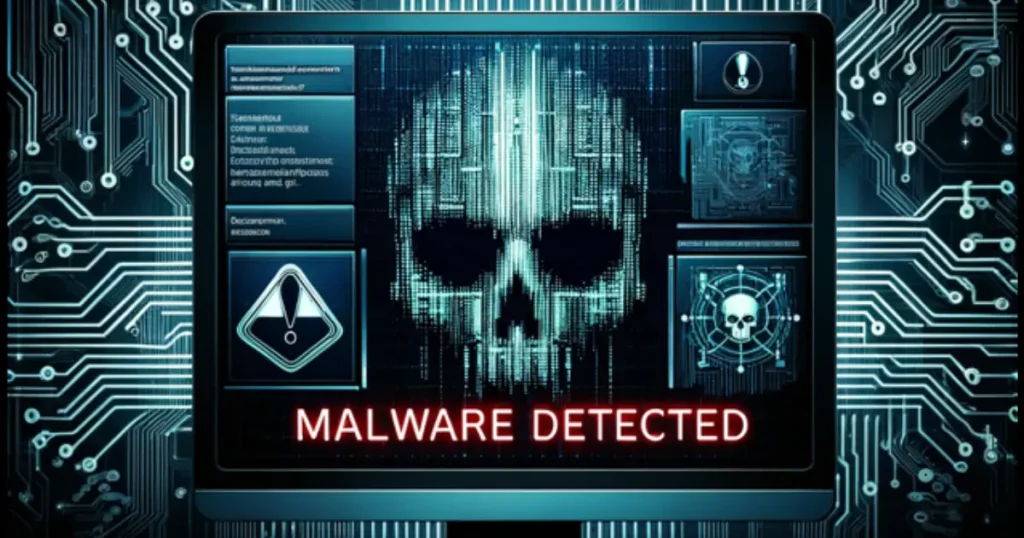Malware is any program or file that damages a computer, network, or server. It includes viruses, worms, trojans, ransomware, spyware, and adware. Cybercriminals use malware to steal information, hijack devices, disrupt operations, and demand ransom.
Understanding malware and its workings is crucial for protecting your digital environment. This blog will explore different types of malware, their effects, and how to safeguard your systems against these threats.
Malware Overview
Malware broadly refers to malicious software aimed at infiltrating, damaging, or controlling computers and networks. It can manifest in the form of executable files, scripts, macros, or other forms of code.
Malware works by exploiting vulnerabilities in operating systems, software applications, and hardware components. Once it infects a system, it can cause a wide range of negative effects, from stealing sensitive data to crashing entire networks.
What Does Malware Do?
The primary function of malware is to inflict harm, steal confidential data, or secure unauthorized entry into a computer system or network. Depending on the malware type, it can execute various malicious actions, including:
Disrupting system operations
Some malware is designed to disrupt a computer’s normal functioning by deleting files, slowing down performance, and crashing systems. These disruptions can cause downtime, productivity loss, and potential data loss, underscoring the need for robust security measures.
Stealing personal information
Malware can collect sensitive data, such as login details, credit card information, and personal data, from compromised computers.
This stolen data can cause identity theft, fraud, or being on the dark web, leading to major financial and personal harm for victims.
Extorting money
Ransomware is a form of malware that locks the files on a user’s computer and requires payment to unlock them. This may result in financial losses for both individuals and organizations. Paying ransom doesn’t ensure file recovery and may invite more attacks, highlighting the need for prevention and backups.
Gaining control over a computer
Certain malware, such as botnets, can turn a computer into a part of a network that carries out cyber attacks without the user’s knowledge. These compromised computers, known as “zombies,” can be directed to participate in larger attacks like Distributed Denial of Service (DDoS) attacks, causing widespread damage.
Displaying unwanted ads
Adware is a type of malware that displays advertisements on an infected computer, often in an intrusive or deceptive manner. These unwanted ads can slow down system performance, create a poor user experience, and sometimes lead to more malicious websites or downloads, further compromising the system.
What are the Different Types of Malware?
Viruses
Viruses are programs designed to replicate by attaching themselves to other files, enabling them to spread from one computer to another. They often cause damage by corrupting or deleting files on the infected computer.
Worms
Worms are self-replicating programs that spread through networks without user interaction. They can harm systems by consuming bandwidth and overloading them.
Trojans
Trojans are software that seems benign but secretly carry harmful code. They often deceive users into downloading them, granting hackers unauthorized device access.

Spyware
Spyware is malware that covertly collects and sends a user’s online activities to the attacker. This can include sensitive personal information such as passwords and credit card numbers.
Adware
Adware, a type of malware, bombards an infected device with unwanted ads, often using intrusive or deceptive tactics. It can significantly hinder user experience and compromise privacy.
Ransomware
Ransomware, a form of malware, encrypts a user’s computer files and demands payment for decryption. This could result in financial losses for both individuals and organizations.
Rootkits
Rootkits are designed to conceal other malicious software on a computer, making it challenging for antivirus programs to detect and eliminate them.
Botnets
Botnets consist of devices infected and controlled by a single attacker, forming a network. They are often used to carry out cyber attacks, such as distributed denial-of-service (DDoS) attacks.
How Do Malware Infections Happen?
Malware infections can happen in a variety of ways, but some common methods include:
Phishing scams
Cybercriminals trick users into opening malicious attachments or clicking infected links with phishing emails. These emails frequently seem to originate from reputable sources, like banks or well-known companies, which makes them more difficult to identify. Clicking on a malicious attachment or link may result in malware being installed, putting personal or corporate data at risk.
Drive-by downloads
This malware infects a computer by automatically downloading itself when a user visits an infected website without the user’s knowledge or consent.
Drive-by downloads exploit vulnerabilities in web browsers, plugins, or other software to execute the download. Users often remain unaware of the infection until their device starts exhibiting unusual behavior or performance issues.
Social engineering
Malware creators often use social engineering, like pretending to be a trusted source or using persuasive language, to trick users into downloading malware.
These tactics can include creating fake websites that mimic legitimate ones or sending messages that create a sense of urgency or fear. By manipulating human emotions and trust, cybercriminals increase their chances of successfully infecting devices with malware.

Exploiting software vulnerabilities
Malware can exploit software vulnerabilities to access computers or networks. Hackers identify and exploit these vulnerabilities to infiltrate systems, steal sensitive data, or cause damage. This is why it’s important to regularly update software with security patches, as updates often include fixes for known vulnerabilities and reinforce the system’s defenses against potential threats.
How to Protect Against Malware
To protect against malware, it is important to take preventative measures, including:
Using antivirus software
Install and update reputable antivirus software on all devices. This will help detect and remove any known malware. Regular scans and updates are crucial to maintaining the security of your system against emerging threats.
Being cautious of email attachments
Avoid opening attachments or clicking on links in emails from unknown sources. Many cyber attacks originate from phishing emails that disguise themselves as legitimate communications.

Always verify the sender’s identity before engaging with any email content.
Keeping software up to date
Regularly update operating systems, applications, and web browsers to patch any security vulnerabilities.
Software developers frequently update to fix bugs and improve security. Ignoring these updates can leave your system exposed to cyber threats.
Being mindful of online downloads
Only download software from trusted sources, and beware of pop-ups or ads with free download offers. Malicious software often masquerades as useful programs. Always ensure the source is legitimate to prevent accidentally downloading malware.
Using a firewall
A firewall blocks unauthorized access to computers or networks, preventing malware from spreading. It also serves as a shield, protecting your internal network from external threats. Configuring your firewall settings properly is essential to ensure maximum protection.
How Do Malware Infections Happen?
In addition to taking preventative measures, it is also important to be prepared for a malware infection. This includes:
Backing up data
Make it a habit to back up crucial files and keep them in a safe place. If you ever fall victim to malware, these backups can be lifesavers, helping you recover lost or encrypted files. For extra safety, it’s wise to use a mix of physical and cloud storage. Consistent backups could be the difference between a minor inconvenience and a major data disaster.
Educating yourself and others
Stay informed about common methods used by cybercriminals to spread malware and educate others on how to stay safe online. Attend cybersecurity workshops, follow trusted sources for the latest trends, and share this knowledge with friends, family, and colleagues. An educated community is less susceptible to falling prey to cyber threats.
Creating strong passwords
Opt for complex, unique passwords for every account to prevent hackers from easily cracking them and installing malware on your devices. A password manager assists in creating and safely keeping complex passwords. Remember to change your passwords frequently and enable two-factor authentication for added security.
Both individuals and organizations need to comprehend and implement preventive strategies against malware to safeguard themselves and their devices from potential infections.
Signs of Malware Infection
- Slow and unresponsive system performance
- Frequent pop-up ads or unexpected changes to web browser settings
- Random crashes or freezing of applications
- Unusual error messages or notifications
- Suspicious network activity, such as large amounts of data being transferred without your knowledge
- Unknown processes running in the background
If you notice any of these signs, it is important to run a thorough scan with your antivirus software and take the necessary actions to remove the infection. Remember, prevention is better than cure for malware infections.
Stay alert and proactive in defending against cyber threats. So, make sure you keep your antivirus software up to date, practice safe online habits, and regularly back up your data. By following these steps, you can lower the risk of malware attacks.
Frequently Asked Questions
How do I remove malware?
To remove malware:
- Conduct a comprehensive scan using trustworthy antivirus or anti-malware programs.
- Follow the instructions to quarantine or delete detected threats.
- Update your OS and apps to fix vulnerabilities, and reset browser settings if altered.
Is malware a bad virus?
Malware is software created to damage, exploit, or compromise computer systems. While viruses are a type of malware, not all malware is viruses. Other types include trojans, ransomware, spyware, and adware. All forms of malware can be harmful and should be removed promptly.
Can malware damage your PC?
Yes, malware can severely damage your PC. It can corrupt files, steal personal information, slow down performance, and even make your computer unusable. Some malware, like ransomware, can lock you out of your system unless a ransom is paid. Protecting your system from malware is crucial.
How to avoid malware?
To avoid malware:
- Ensure you use reliable antivirus software and regularly update it.
- Steer clear of clicking on suspicious links or downloading attachments from unknown sources.
- Keep your operating system and software up-to-date.
- Use strong, unique passwords and consider enabling two-factor authentication for extra security.
How do I scan for malware?
To scan for malware, follow these steps:
- Install a reputable antivirus or anti-malware software.
- Update the software for the latest virus definitions.
- Run a full system scan to check all files and programs.
- Follow any instructions to delete or quarantine identified threats.
- Consider scheduling regular scans to keep your system protected.

